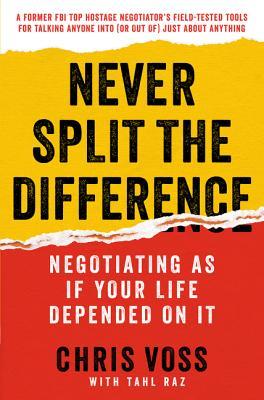Wherever you go, whatever you do, you are negotiating or making deals to benefit you as much as you can. Whether buying clothes or interviewing for a new job, you constantly negotiate your interest. For the sole purpose of surviving, you need to have held control over the competitive edge of any negotiation.
The world works on the ethic of equivalent exchange. You have to offer something to gain something. Sounds simple enough, right? I can assure you; It’s not. The other end will always try to take more from you and give less. To win in these situations, you will have to fight to preserve your autonomy.
In this book, Chris Voss, a former kidnapping negotiator at the FBI, shares insights rooted in real-life experiences to give the readers the winning edge over any discussion.
Here is a brief full-book summary.
Book Details
| Original Title | Never Split the Difference: Negotiating As If Your Life Depended On It |
| Author | Chris Voss |
| Edition Language | English |
| Publisher | Harper Business |
| Genre | Self-help book |
| Pages | 274 pages |
| Size | 2.5 MB |
| Format | |
| First Published | May 17th, 2016 |
Never Split the Difference PDF
Never Split the Difference by Chris VossA Brief Introduction
Never Split the Difference takes you inside Voss’s world of high-stakes negotiations, revealing the ‘nine crucial concepts’ that helped Voss and his colleagues succeed when it counted most — when people’s lives were on the line. After stint policing on the unpleasantly rough streets of Kansas City, Missouri, Chris Voss joined the FBI, where his employment as an abduction negotiator brought him face-to-face with bank robbers, gang leaders, and terrorists.
The Nine Key Principles
Active Listening
The first rule is don’t rush them. Maintain a friendly, calm, and upbeat tone while asking questions. Generally, humans are passive listeners, selectively hearing what we want to hear and filtering out everything else.
Using the ‘no rush’ tactic and listening to them actively creates a safe environment where they trust you and eventually open up about the unrevealed pieces of information.
Mirroring the ‘Other’ Party
People generally feel insecure about sharing something they fear to be judged. That’s why it’s all about bonding with them and showing them that you and they are so indifferent. It will snap them out of that fear. It will also prove that you like them for who they are and you are listening to them attentively.
How to imitate the speech patterns, if you may ask, Voss, says it’s simple, just renunciate the last three words of their previous conversation.
Labeling Their Pain Instead of Feeling It
Empathy creates trust. But in negotiations, you have to be more tactical. You have to use tactical empathy to gain their confidence. Utilize labeling to alleviate their anxieties by bringing them to the surface.
Labeling requires identifying and vocalizing another person’s feelings using neutral, qualified third-person terminology such as “It looks like you are…”
Beware “YES” – “Master NO”
Most people love a secure environment to share information. They prefer being in control of their situation, especially the guilty ones. Accepting the other party’s refusal to reveal any information is fundamental to reassuring that security to the other party.
Make them believe that you are not trying to withhold information from them. Give them the control to set their own limits by leaving them the choice to say “NO.”
Summarize the conversation
By re-articulating what the other party has said and labeling their emotions create a summary in your mind. Then start with two words: “That’s Right.” And afterward, you can proceed with whatever you want to say. In this way, you agree with the other party while you can imply anything to them.
Bend Their Reality
It’s more like you have to pull the other party into your reality by tactical influence. The word “Fair” holds the maximum leverage in the negotiation world. You have to influence your counterpart in thinking that the deal is fair for them. And voila, you hold the leverage now.
How do you get to think them od the deal is fair? Well, as the author suggests. Anchor their emotions, use odd ones while using numbers, pivot to non-monetary terms, and most importantly, let them talk first.
Create the Illusion of Control
Never force your counterpart to admit that you’re right. Ask questions starting with How or What to transform conflict into collaboration.
The Ackerman Model
This is an offer-counter offer method. The model provides six steps to do so.
- Determine your goal
- Aim for 65% of your desired price. Calculate three descending rises (85, 95, and 100 percent).
- Before increasing your offer, show empathy and several ways of saying “No” to elicit a response.
- Use odd numbers
- Add a non-monetary item as your final amount to signal you’re out.
Find the Black Swan
Black Swan is considered a powerful leverage multiplier, the maximal unknown portion of a negotiation.
Take the conversation away from the negotiating table and into the other party’s emotions and lives. That is where Black Swans can be found.
The writer, in his book, tried to break down people’s psychology by critically observing how their minds work and provided strategies for exploiting their blindspots to bring out the information you aspire to know. Through his long years of experience as an intelligence professional, Voss broke down the above-mentioned essential rules of negotiations.








